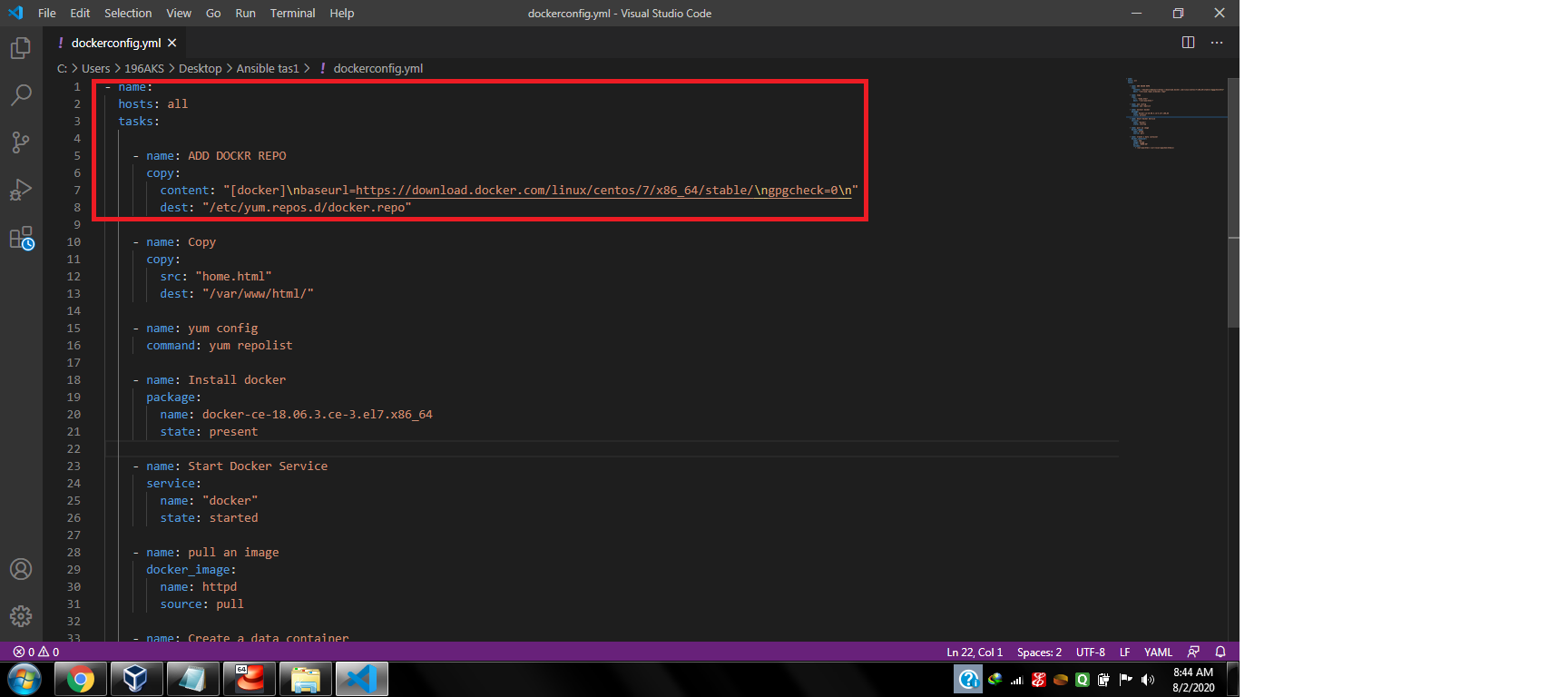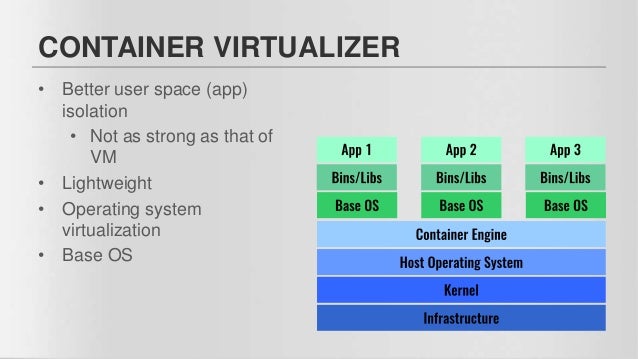Hello Everybody,
I ran into an issue today.
After installing “docker-compose” the docker client does not start anymore.
- Aug 10, 2019 Docker looks for centos image locally, and it is not found, it starts downloading the centos image from Docker registry. Once the image has been downloaded, it will start the container and echo the command Hello-World in the console which you can see at the end of the output.
- I just installed the latest release of docker-ce on CentOS, but I can't reach published ports from a neighboring server and can't reach the outside from the container itself. Running a plain vanilla CentOS 8 with NetworkManager and FirewallD enabled. Default firewall zone is public. Versions: docker-ce 19.03.3 (official Docker RPM).
The configuration is as follow:
/etc/docker/daemon.json
{
“debug”: true,
“insecure-registries”: [“nexus-domain.com:10000” ,“10.100.x.x:10000/”],
“hosts”: [“tcp://0.0.0.0:2376”, “unix:///var/run/docker.sock”],
“tls”: false
}
Nov 14, 2017 This is a bug report This is a feature request I searched existing issues before opening this one Expected behavior Docker should be started. Actual behavior Cannot start docker At CentOS 7. Try to start docker. But, it is failed.
The docker service would be run if I take off the entrie “unix:///var/run/docker.sock”
But then, all of my container are disappeared. So this is not a option.
Thanks
Version
Centos 7 Docker Start Service
Client:
Version: 17.06.0-ce
API version: 1.30
Go version: go1.8.3
Git commit: 02c1d87
Built: Fri Jun 23 21:23:31 2017
OS/Arch: linux/amd64
I would be happy if anybody knows an solution.
Estimated reading time: 10 minutes
To get started with Docker Engine on CentOS, make sure youmeet the prerequisites, theninstall Docker.
Prerequisites
OS requirements
To install Docker Engine, you need a maintained version of CentOS 7 or 8.Archived versions aren’t supported or tested.
The centos-extras repository must be enabled. This repository is enabled bydefault, but if you have disabled it, you need tore-enable it.
The overlay2 storage driver is recommended.
Uninstall old versions
Older versions of Docker were called docker or docker-engine. If these areinstalled, uninstall them, along with associated dependencies.
It’s OK if yum reports that none of these packages are installed.
The contents of /var/lib/docker/, including images, containers, volumes, andnetworks, are preserved. The Docker Engine package is now called docker-ce.
Installation methods
You can install Docker Engine in different ways, depending on your needs:
Most usersset up Docker’s repositories and installfrom them, for ease of installation and upgrade tasks. This is therecommended approach.
Some users download the RPM package andinstall it manually and manageupgrades completely manually. This is useful in situations such as installingDocker on air-gapped systems with no access to the internet.
In testing and development environments, some users choose to use automatedconvenience scripts to install Docker.
Install using the repository
Before you install Docker Engine for the first time on a new host machine, you needto set up the Docker repository. Afterward, you can install and update Dockerfrom the repository.
Set up the repository
Install the yum-utils package (which provides the yum-config-managerutility) and set up the stable repository.
Optional: Enable the nightly or test repositories.
These repositories are included in the docker.repo file above but are disabledby default. You can enable them alongside the stable repository. The followingcommand enables the nightly repository.
To enable the test channel, run the following command:
You can disable the nightly or test repository by running theyum-config-manager command with the --disable flag. To re-enable it, usethe --enable flag. The following command disables the nightly repository.
Learn about nightly and test channels.
Install Docker Engine
Install the latest version of Docker Engine and containerd, or go to the next step to install a specific version:
If prompted to accept the GPG key, verify that the fingerprint matches
060A 61C5 1B55 8A7F 742B 77AA C52F EB6B 621E 9F35, and if so, accept it.Got multiple Docker repositories?
If you have multiple Docker repositories enabled, installingor updating without specifying a version in the
yum installoryum updatecommand always installs the highest possible version,which may not be appropriate for your stability needs.Docker is installed but not started. The
dockergroup is created, but no users are added to the group.To install a specific version of Docker Engine, list the available versionsin the repo, then select and install:
a. List and sort the versions available in your repo. This example sorts results by version number, highest to lowest, and is truncated:
The list returned depends on which repositories are enabled, and is specificto your version of CentOS (indicated by the
.el7suffix in this example).b. Install a specific version by its fully qualified package name, which is the package name (
docker-ce) plus the version string (2nd column) starting at the first colon (:), up to the first hyphen, separated by a hyphen (-). For example,docker-ce-18.09.1.Docker is installed but not started. The
dockergroup is created, but no users are added to the group.Start Docker.
Verify that Docker Engine is installed correctly by running the
hello-worldimage.This command downloads a test image and runs it in a container. When thecontainer runs, it prints an informational message and exits.
Docker Engine is installed and running. You need to use sudo to run Dockercommands. Continue to Linux postinstall to allownon-privileged users to run Docker commands and for other optional configurationsteps.
Upgrade Docker Engine
To upgrade Docker Engine, follow the installation instructions,choosing the new version you want to install.
Start Docker Service At Boot Centos

Install from a package
If you cannot use Docker’s repository to install Docker, you can download the.rpm file for your release and install it manually. You need to downloada new file each time you want to upgrade Docker Engine.
Go to https://download.docker.com/linux/centos/and choose your version of CentOS. Then browse to
x86_64/stable/Packages/and download the.rpmfile for the Docker version you want to install.Note: To install a nightly or test (pre-release) package,change the word
stablein the above URL tonightlyortest.Learn about nightly and test channels.Install Docker Engine, changing the path below to the path where you downloadedthe Docker package.
Docker is installed but not started. The
dockergroup is created, but nousers are added to the group.Start Docker.
Verify that Docker Engine is installed correctly by running the
hello-worldimage.This command downloads a test image and runs it in a container. When thecontainer runs, it prints an informational message and exits.
Docker Engine is installed and running. You need to use sudo to run Docker commands.Continue to Post-installation steps for Linux to allownon-privileged users to run Docker commands and for other optional configurationsteps.
Upgrade Docker Engine
To upgrade Docker Engine, download the newer package file and repeat theinstallation procedure, using yum -y upgradeinstead of yum -y install, and pointing to the new file.
Install using the convenience script
Docker provides convenience scripts at get.docker.comand test.docker.com for installing edge andtesting versions of Docker Engine - Community into development environments quickly andnon-interactively. The source code for the scripts is in thedocker-install repository.Using these scripts is not recommended for productionenvironments, and you should understand the potential risks before you usethem:
- The scripts require
rootorsudoprivileges to run. Therefore,you should carefully examine and audit the scripts before running them. - The scripts attempt to detect your Linux distribution and version andconfigure your package management system for you. In addition, the scripts donot allow you to customize any installation parameters. This may lead to anunsupported configuration, either from Docker’s point of view or from your ownorganization’s guidelines and standards.
- The scripts install all dependencies and recommendations of the packagemanager without asking for confirmation. This may install a large number ofpackages, depending on the current configuration of your host machine.
- The script does not provide options to specify which version of Docker to install,and installs the latest version that is released in the “edge” channel.
- Do not use the convenience script if Docker has already been installed on thehost machine using another mechanism.
This example uses the script at get.docker.com toinstall the latest release of Docker Engine - Community on Linux. To install the latesttesting version, use test.docker.com instead. Ineach of the commands below, replace each occurrence of get with test.
Warning:
Always examine scripts downloaded from the internet beforerunning them locally.
If you would like to use Docker as a non-root user, you should now consideradding your user to the “docker” group with something like:
Remember to log out and back in for this to take effect!
Warning:
Adding a user to the “docker” group grants them the ability to run containerswhich can be used to obtain root privileges on the Docker host. Refer toDocker Daemon Attack Surfacefor more information.
Docker Engine - Community is installed. It starts automatically on DEB-based distributions. OnRPM-based distributions, you need to start it manually using the appropriatesystemctl or service command. As the message indicates, non-root users can’trun Docker commands by default.
Note:
To install Docker without root privileges, seeRun the Docker daemon as a non-root user (Rootless mode).
Upgrade Docker after using the convenience script
If you installed Docker using the convenience script, you should upgrade Dockerusing your package manager directly. There is no advantage to re-running theconvenience script, and it can cause issues if it attempts to re-addrepositories which have already been added to the host machine.
Uninstall Docker Engine
Uninstall the Docker Engine, CLI, and Containerd packages:
Images, containers, volumes, or customized configuration files on your hostare not automatically removed. To delete all images, containers, andvolumes:
You must delete any edited configuration files manually.


Next steps
- Continue to Post-installation steps for Linux.
- Review the topics in Develop with Docker to learn how to build new applications using Docker.
Centos 6 Start Docker Daemon
requirements, apt, installation, centos, rpm, install, uninstall, upgrade, update
